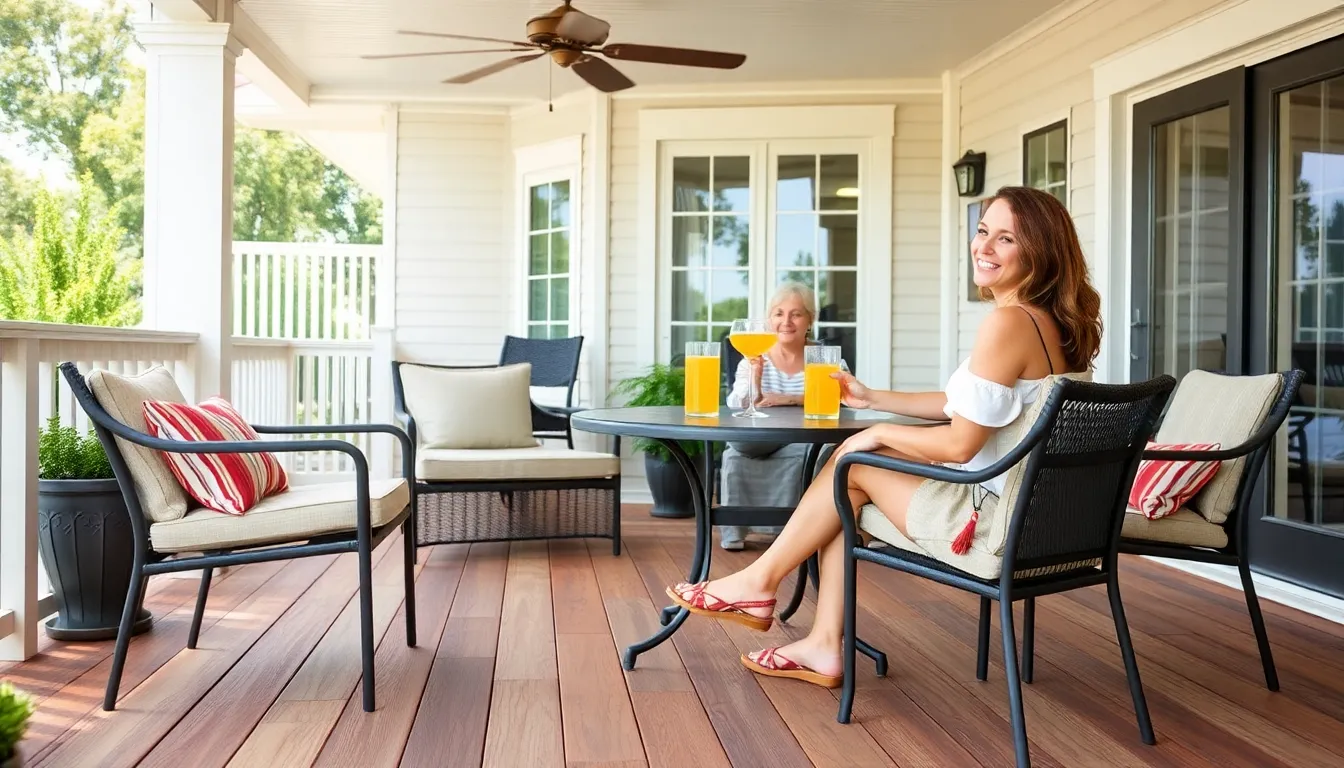Imagine lounging on your deck, drink in hand, while the sun sets over the horizon. Now picture that same deck not splintering your feet or fading into oblivion after a few seasons. Enter composite decking, the superhero of outdoor spaces. It combines the best of wood and plastic, giving homeowners a stunning, low-maintenance option that stands up to the elements like a champ.
Gone are the days of endless sanding and staining. With composite decking, it’s all about enjoying life without the hassle. Plus, it’s eco-friendly, so you can feel good about your choice while you kick back and relax. Whether you’re hosting a barbecue or just soaking up some sun, this decking option makes every moment count. Get ready to elevate your outdoor experience and impress your guests with a deck that’s as stylish as it is durable.
Table of Contents
ToggleOverview Of Composite Decking
Composite decking combines wood fibers and plastic, resulting in a durable decking solution. This material offers a range of features that appeal to homeowners.
What Is Composite Decking?
Composite decking consists of a blend of recycled wood and plastic products. This innovative material has gained popularity due to its versatility and resistance to decay. Many manufacturers create composite boards in various colors and textures, mimicking the appearance of traditional wood. Its design helps reduce environmental impact by reusing materials that may otherwise contribute to waste.
Benefits Of Composite Decking
Composite decking provides numerous advantages that enhance outdoor spaces. It requires minimal upkeep, eliminating the need for regular sanding or staining. This feature saves homeowners time and effort over the years. Additionally, composite boards resist fading, splintering, and warping, offering longevity and durability. Many products feature UV protection, ensuring colors remain vibrant despite sun exposure. Environmental benefits include using recycled materials, promoting sustainability in outdoor living.
Types Of Composite Decking

Composite decking comes in various types, each with unique features and benefits. Understanding the differences helps homeowners select the most suitable option for their outdoor spaces.
Solid vs. Hollow Composite Decking
Solid composite decking comprises a solid core, providing enhanced durability and stability. Homeowners benefit from its resistance to warping and damage, making it ideal for high-traffic areas. Hollow composite decking, on the other hand, features a lightweight design, which reduces material costs. Its construction allows for better drainage, but it may not offer the same level of strength as solid options. Each type serves specific needs, catering to preferences for performance and budget.
Capped vs. Uncapped Composite Decking
Capped composite decking includes a protective outer layer that seals the core material. This feature enhances resistance to moisture, staining, and fading, promoting longevity. Uncapped composite decking lacks this protective layer, making it more susceptible to environmental damage. Although more affordable, it typically requires more maintenance. For those prioritizing durability and aesthetics, capped options present a strong choice in the long run. Uncapped varieties might attract budget-conscious homeowners seeking immediate savings.
Installation Process
Installing composite decking requires preparation and the right approach. This section outlines the essential tools, materials, and a step-by-step guide for an effective installation.
Tools And Materials Needed
Gathering the right tools and materials ensures a successful installation. Key tools include a power saw, drill, tape measure, and a level for precision. Use a square for accurate angles and a safety mask for protection during cutting. Essential materials consist of composite decking boards, fasteners designed for composite materials, and a joist system for proper support. Having a chalk line helps mark straight cutting lines, ensuring a clean installation process.
Step-by-Step Installation Guide
Following a simple step-by-step installation guide simplifies the process. Start by preparing the area, ensuring the ground is leveled and free from debris. Lay down the substructure using treated wood or metal joists, maintaining proper spacing according to manufacturer guidelines. Next, attach the composite boards securely, following the recommended fastener placement. Leave necessary gaps for expansion and contraction based on temperatures. Cut board lengths carefully to fit corners or edges, ensuring a neat finish. Finally, inspect the installation for stability and adjustments before usage.
Maintenance And Care
Composite decking requires minimal maintenance, yet a few simple practices keep it looking great over time.
Cleaning Tips For Composite Decking
Regular cleaning enhances the appearance and longevity of composite decking. Use a broom or leaf blower to remove debris, ensuring a clean surface. For stains, a mixture of warm water and mild soap usually works well. Employ a non-abrasive scrub brush to gently scrub any tough spots. Additionally, the use of a pressure washer on a low setting can help remove dirt build-up. Avoid harsh chemicals, as they may damage the decking’s finish. Rinse thoroughly after cleaning to prevent residue.
Long-Term Care Considerations
Long-term care requires attention to factors influencing durability. Regular inspections help identify fading or wear, allowing for timely action. Ensure all fasteners and connections remain secure to maintain stability. Consider using product-specific cleaners designed for composite materials for more thorough maintenance. Store furniture and heavy objects off the surface during extreme weather to avoid unnecessary pressure and damage. Finally, shading the deck with umbrellas or pergolas may prevent ultraviolet degradation, extending its life.
Cost Analysis
Evaluating the cost of composite decking requires considering both the initial investment and long-term savings. Homeowners find that while the upfront cost often exceeds traditional wood options, savings accrue over time through reduced maintenance and replacement needs.
Initial Investment Vs. Long-Term Savings
Initial pricing for composite decking can range from $3 to $7 per square foot. Homeowners typically notice minimal upkeep expenses since the material resists fading, splintering, and warping. Investing in composite decking reduces expenditures on staining and sealing compared to wood alternatives. The longevity of composite materials, with an average lifespan of 25 to 30 years, leads to lower overall costs in the long run. Choosing composite boards often results in greater value despite the higher initial price tag, contributing to enhanced financial planning for property improvements.
Comparing Composite Decking Prices
Comparative shopping reveals a variety of price points across the market. Several brands offer options starting around $2.50 for basic models, while premium boards can exceed $9 per square foot. The selection includes different textures, colors, and warranties that impact pricing. Capped composite decking typically commands a higher price due to extra protective features. Bulk purchasing may also provide discounts, thereby influencing overall project costs. In researching options, homeowners often benefit from consulting local retailers and online reviews for the best deals to match their budget.
Composite decking stands out as a practical choice for enhancing outdoor living spaces. Its blend of recycled materials not only reduces environmental impact but also provides a long-lasting solution that requires minimal upkeep. Homeowners can enjoy the aesthetic appeal of various colors and textures without the hassle of traditional wood maintenance.
With options like solid and capped composite boards, there’s a solution for every need and budget. Proper installation and care can further extend its lifespan, making it a smart investment. As outdoor spaces continue to gain importance, composite decking proves to be a stylish and durable option for creating inviting areas for relaxation and gatherings.



